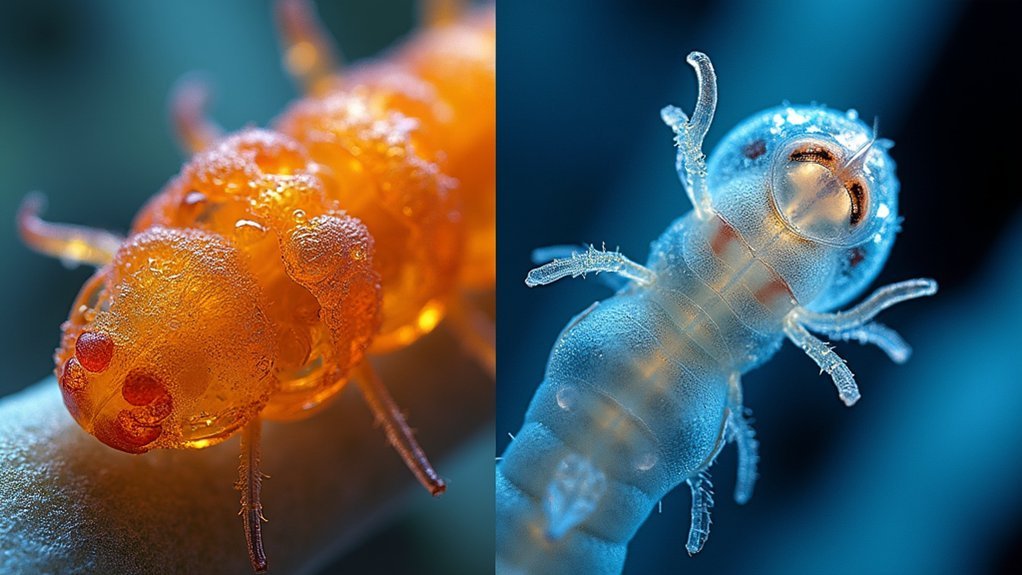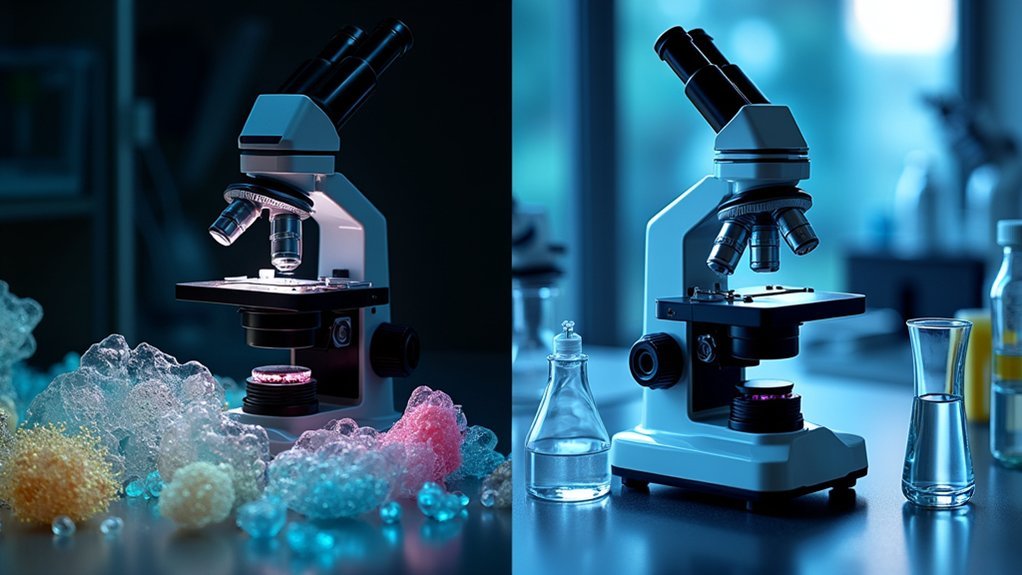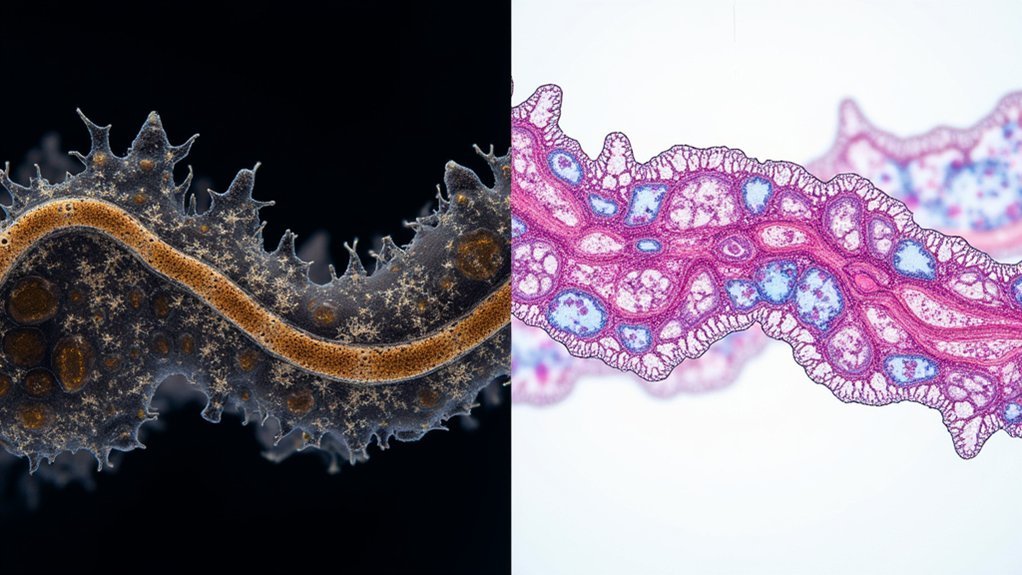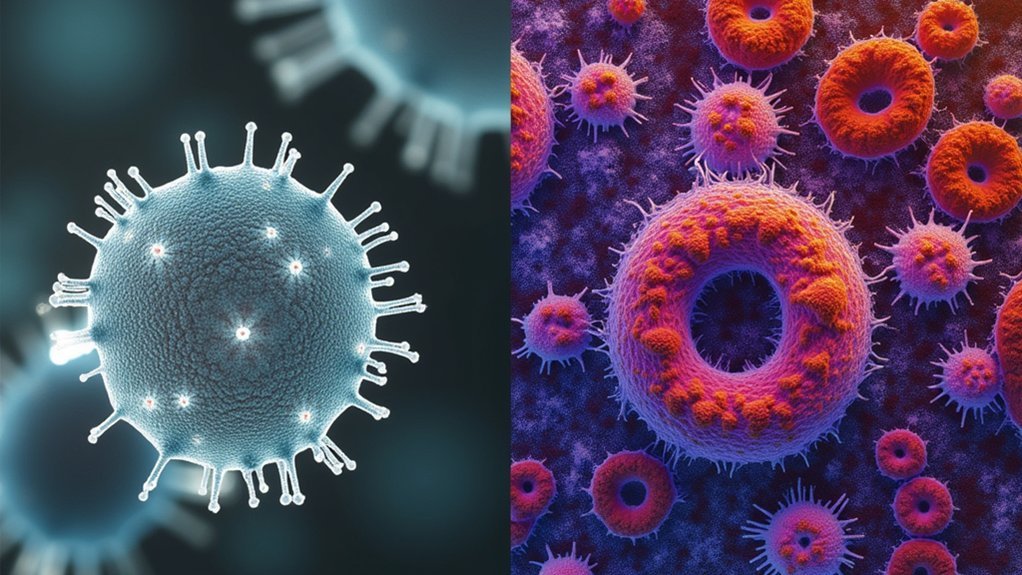Phase contrast microscopy reveals transparent cell structures without staining, making it ideal for living specimens. You’ll see cellular details that remain invisible in brightfield microscopy unless samples are stained. Brightfield offers simpler setup and works well for routine observation of stained tissues, while phase contrast preserves natural cell behavior during long-term studies. Your specimen type and research needs should determine which technique will deliver the clearest visualization of critical structures.
The Fundamental Principles of Phase Contrast Microscopy

While invisible to conventional microscopy, transparent biological specimens spring to life under phase contrast microscopy. This revolutionary technique, developed by Frits Zernike in the 1930s, converts phase differences in light into brightness variations, revealing cellular details that brightfield imaging simply can’t detect without staining.
The magic happens when light passes through an annular aperture and a quarter-wave phase plate, transforming optical density differences into high contrast visuals. You’ll see unstained specimens (typically 5-10 micrometers thick) with remarkable detail as denser structures appear darker against a lighter background. This makes it suitable for observing living cells and dynamic processes.
Be aware of artifacts like halos that may appear around specimen edges. For best phase matching, look for objectives with green Ph1, Ph2, or Ph3 inscriptions.
How Brightfield Microscopy Creates Images
When you look through a brightfield microscope, you’re seeing images formed as light passes through the specimen and creates contrast between absorbed and transmitted wavelengths.
The specimen appears dark against a bright background because its stained elements absorb specific light wavelengths while the surrounding field transmits light directly to your eye.
This fundamental interaction between light and specimen creates the visibility of cellular structures, with staining methods enhancing natural contrast by introducing light-absorbing chromophores to otherwise transparent biological materials.
Image Formation Principles
Brightfield microscopy creates images through a remarkably straightforward optical process that relies on light transmission and absorption. When you examine biological specimens, the illuminator directs light from below the stage through your sample, while the condenser lens focuses this light for peak visualization.
Structures within your specimen absorb or scatter specific wavelengths, appearing darker against the bright background.
The total magnification you observe equals the ocular lens magnification (typically 10×) multiplied by your objective lens magnification. For example, a 40× objective produces 400× total magnification.
Unlike phase contrast image techniques that visualize phase shifts or darkfield illumination that enhances edges, brightfield microscopy depends on natural optical properties or stains to generate contrast. This approach works well for stained specimens but has limited effectiveness for viewing fine details in unstained samples beyond 1000× magnification.
Light Interaction Mechanisms
At its core, brightfield microscopy relies on the differential absorption of light as it passes through your specimen. This optical system produces images by creating contrast between the specimen and its bright background.
Unlike phase contrast microscopy, which visualizes phase shift differences, brightfield illumination depends on how materials interact with light.
When examining specimens at high magnifications, you’ll notice:
- Light absorption – Stained components appear darker as chromophores absorb specific wavelengths
- Illumination pathway – Light travels upward through your specimen from below the stage
- Contrast generation – Denser structures block more light, creating natural contrast
- Visibility limitations – Transparent biological materials often remain difficult to visualize without staining
This light interaction explains why brightfield microscopy works exceptionally well with stained preparations but struggles with unstained transparent specimens.
Key Differences in Contrast and Visibility Between Methods

You’ll immediately notice how phase contrast microscopy reveals cellular details that remain invisible in brightfield imaging, especially when examining transparent specimens without staining.
While brightfield requires you to add dyes that may alter your sample’s natural state, phase contrast converts optical path variations into visible contrast differences, preserving the specimen’s living conditions.
This fundamental difference makes phase contrast the superior choice when you’re studying live cell dynamics, as it transforms normally invisible refractive index variations into readily observable brightness differences.
Cellular Detail Visualization
When examining the intricate landscape of cells, the difference between phase contrast and brightfield microscopy becomes immediately apparent in their ability to reveal structural details.
Phase contrast microscopy excels with transparent specimens, converting optical phase shifts into visible contrast without requiring stains that might alter your biological samples.
- Phase contrast microscopy reveals fine cellular structures in unstained samples, making optically dense areas appear darker against the background.
- Brightfield microscopy requires staining for adequate visualization, as it depends on light absorption to create contrast.
- Live cell imaging benefits tremendously from phase contrast, allowing you to observe dynamic processes in real-time.
- Transparent cellular components remain virtually invisible in brightfield but become clearly defined with phase contrast technology.
Transparent Specimen Detection
The fundamental challenge of observing transparent specimens becomes immediately evident as you compare phase contrast and brightfield techniques side by side. While brightfield microscopy leaves transparent structures virtually invisible without staining, phase contrast microscopy transforms these “ghosts” into clearly defined objects with remarkable detail.
| Technique | Transparent Specimen Visibility | Impact on Living Cells |
|---|---|---|
| Phase Contrast | Excellent definition without stains | Preserves natural cell behavior |
| Brightfield | Nearly invisible without staining | Stains may alter or kill cells |
| Difference | Night and day visibility contrast | Critical for biological research |
You’ll find phase contrast microscopy indispensable when you need to observe structures in living cells without disrupting their natural processes. This capability makes it the superior choice for biological research where maintaining cellular integrity during observation is paramount.
Optical Path Variations
Light’s journey through each microscopy system creates fundamentally different visual outcomes, explaining why phase contrast and brightfield techniques yield such contrasting results. The optical path variations fundamentally determine what you’ll see when examining specimens:
- Phase contrast microscopy converts phase shifts into amplitude differences, making unstained, transparent specimens visible without requiring dyes that might damage live cells.
- Brightfield microscopy relies on light absorption, requiring stained samples for adequate contrast of cellular structures.
- Contrast enhancement in phase contrast occurs through an annular aperture and quarter-wave phase plate, revealing fine details at high magnification.
- Optical artifacts like halos appear in phase contrast due to the phase shifting process, while brightfield lacks these artifacts but struggles with transparent specimens.
Sample Preparation Requirements for Both Techniques

Choosing between phase contrast and brightfield microscopy often depends on your sample preparation capabilities and experimental needs.
For brightfield microscopy, you’ll need to stain your specimens to enhance contrast, as this technique relies on light absorption differences. Your samples can be relatively thick, but without staining, transparent specimens won’t show much detail.
Phase contrast microscopy eliminates the staining requirement, allowing you to observe living cells in their natural state. This technique utilizes differences in optical density to visualize unstained specimens, but you’ll need specialized optics including phase plates and annular apertures.
Keep your specimens thin (5-10 micrometers) for best results. If you’re conducting live cell imaging and want to preserve sample integrity while revealing fine cellular structures, phase contrast offers clear advantages over brightfield’s more invasive preparation process.
Live Cell Imaging: Why Phase Contrast Excels
When observing living cells in their natural state, phase contrast microscopy stands out as the superior technique for researchers and microscopists.
Unlike brightfield microscopy, phase contrast converts phase shifts into brightness variations, revealing structures in specimens with low inherent contrast.
Why you’ll get better results with phase contrast for live cell imaging:
- No staining required – Observe cells without compromising their viability or altering their natural state
- Enhanced visibility – Utilizes refractive index differences to highlight transparent structures invisible in brightfield
- Real-time observation – Capture dynamic cellular processes and morphology changes as they occur
- Superior detail – Produces high-resolution images of organelles and fine structures critical for biological research
This capability makes phase contrast indispensable when studying living specimens 5-10 micrometers thick.
Applications and Limitations in Research Settings

Despite their complementary roles in scientific research, phase contrast and brightfield microscopy serve distinct applications with unique advantages and limitations.
When conducting live cell studies, you’ll find phase contrast microscopy invaluable for high-contrast imaging of unstained biological samples without toxic stains. This makes it perfect for long-term observation of cellular structures at 5-10 micrometers thickness.
However, be aware that artifacts like halos may obscure boundary details.
Brightfield microscopy offers simplicity for routine laboratory work and educational settings, requiring minimal optical components for effective imaging.
It’s your go-to method for stained specimens where absorption enhances visibility. The trade-off is its limited effectiveness with unstained samples due to poor contrast, typically requiring thicker specimens or staining for best results.
Choosing the Right Technique for Your Specimen Type
The selection of an appropriate microscopy method hinges primarily on your specimen’s inherent properties.
Consider the nature of your sample when deciding between brightfield and phase contrast microscopy for ideal results.
- Specimen transparency – Use brightfield microscopy for stained samples with strong absorption; choose phase contrast microscopy for unstained specimens and live cells.
- Contrast requirements – Brightfield offers limited visibility for transparent samples while phase contrast provides contrast enhancement without stains.
- Equipment availability – Brightfield requires simpler optical setup compared to phase contrast’s specialized components (annular aperture and phase plate).
- Research needs – Consider your magnification needs and resolution capabilities when studying cellular structures—phase contrast excels with delicate organisms that would be damaged by staining procedures.
Frequently Asked Questions
Why Is Phase Contrast Better Than Bright Field?
Phase contrast is better than bright field because you’ll see transparent specimens without staining, get higher contrast in living cells, and observe fine details through optical phase shifts rather than just light absorption.
What Is the Advantage of Using Phase Contrast Microscopy Over Brightfield Quizlet?
Phase contrast microscopy gives you better visibility of transparent specimens without staining. You’ll see cellular details that brightfield can’t show, as it converts phase differences into brightness variations, preserving your specimen’s natural state.
Which Microscope Is Best for Viewing an Unstained Specimen?
You’ll want to use a phase contrast microscope for viewing unstained specimens. It converts phase differences into visible brightness variations, letting you see transparent structures clearly without staining, unlike brightfield which requires stains.
Is Dic Better Than Phase Contrast?
Yes, DIC is generally better than phase contrast for thicker specimens. You’ll get clearer images with enhanced 3D detail, finer resolution, and fewer artifacts like halos when viewing complex or detailed biological structures.
In Summary
You’ve now seen how phase contrast provides superior visibility for transparent specimens without staining, while brightfield offers simplicity and true color representation. When examining live cells, you’ll want phase contrast; for stained samples, brightfield serves you better. Consider your specimen type, contrast needs, and equipment availability when choosing between these complementary techniques. Neither method is universally superior—each excels in specific applications.





Leave a Reply